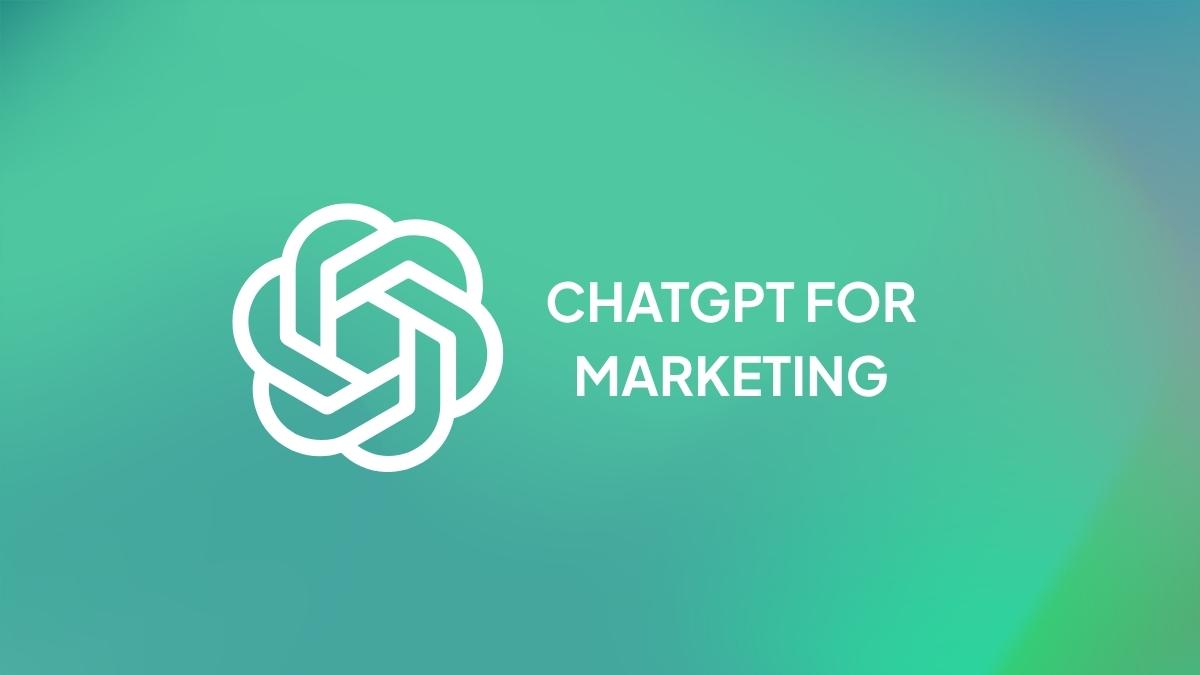Let’s be honest, marketing today is exhausting. There’s always another email to write, another caption to tweak, another blog post waiting to be outlined… and somehow, never enough hours in the day to get it all done.
That’s exactly why tools like ChatGPT for Marketing are becoming such a big deal.
Not because they’re replacing marketers (far from it), but because they take the pressure off. Whether you need fresh content ideas, a second brain for brainstorming, or just a decent draft to stop staring at a blank screen, it’s like having a smart assistant who’s always on.
Since it launched, ChatGPT has quietly slipped into the daily workflows of solo creators, agency teams, and big brands alike. But here’s the thing: the people getting the most out of it aren’t just using it… they’ve learned how to prompt it, guide it, and build on what it gives back.
This guide will show you how to do exactly that.
Table of Contents
What is ChatGPT and How Does It Work?
At its heart, ChatGPT is like a supremely well-read intern. It’s read (a lot) and learned to predict what word comes next. You give it a prompt, and it replies with the best possible continuation, like autocomplete on coffee, content, and creativity.
The Magic Behind the Curtain
It runs on “GPT” models, GPT‑3.5, GPT‑4, and the new kid, GPT‑4o (which handles audio, images…the works). Think of them as versions of Photoshop: more powerful, smarter, and a bit more human each time.
Free vs. Paid Versions (Quick Cheat Sheet)
| Version | Good for… | Limitations |
| 3.5 (free) | Fast drafting, basic ideas | Stumbles on nuance, fluffier text |
| GPT‑4 | Complex briefs, clever copy | Takes longer, costs a bit |
| GPT‑4o | Multimodal: images, voice, more | Still rolling out publicly |
Pro Tip: Start with 3.5 if you’re testing the waters. Upgrade to GPT‑4 for polished work, especially when tone matters.
Is ChatGPT Good for Marketing?
Areas It Crushes
- Idea generation: stuck on a blank page? ChatGPT’s got your back.
- Repurposing: turn a long blog into tweets, LinkedIn snippets, even emails.
- Speedy drafts: headlines, CTAs, email subject lines… in seconds.
Areas It Can’t Nail Alone
- Real-time data: it won’t know today’s stock price or KPIs unless you input them.
- Brands’ secret sauce: it can replicate tone, but not deep lived experience.
- 100% fact accuracy: always double-check. It might “hallucinate” specifics.
When to Use Vs. Skip It
✅ Use it when… you need fresh ideas, speed, or basic copy to polish.
🚫 Skip it when… you require sensitive data, legal oversight, or high-stakes decisions.
Top Use Cases of ChatGPT in Marketing
Here’s the real juice, how to use ChatGPT day-to-day for maximum impact:
1. Content Creation & Ideation
What it can do: create blog outlines, generate hooks, even draft long-form text.
Example use:
- Prompt: “Write a blog outline for ‘Eco‑friendly packaging trends 2025’ targeting small e‑commerce brands.”
- Prompt expansion: “Now draft the intro, make it playful and mention sustainability stats.”
Bonus: Batch repurposing:
“Turn that 800‑word blog into five punchy LinkedIn posts, with different angles.”
Boom, social with less sweat.
2. Lead Generation & Funnel Copy
What it nails: landing pages, drip sequences, snappy lead magnets.
Example prompt:
“Act as a B2B copywriter. Write 3 hero section options for a CRM tool landing page aimed at solopreneurs.”
Need a lead magnet idea?
“List 10 free e‑book ideas for marketing freelancers, and add catchy titles.”
3. Social Media Marketing
What it does: catchy captions, hooks, content calendars, even meme copy.
Example prompt:
“You’re a TikTok content strategist. Draft a weekly content calendar for an indie coffee shop.”
And then:
“Give me 5 carousel post ideas about coffee farming sustainability.”
4. Email Marketing
What it helps with: subject lines, email flows, A/B tests.
Example prompt:
“Act as an email marketer. Generate 8 subject lines for a new online course launch, targeting busy moms.”
Or a drip sequence:
“Write a 3‑email onboarding sequence for new users with personalized tone.”
5. Market Research & Customer Insights
What it offers: persona sketches, competitor breakdowns, pain point lists.
Example prompt:
“List 5 pain points small gyms face when choosing a scheduling app.”
Want competitive intelligence?
“Compare features and marketing angles of GymMaster vs. Mindbody.”
How NOT to Use ChatGPT for Marketing
Everyone’s telling you what to do with ChatGPT. But here’s what they’re not saying, how not to use it if you don’t want to end up with flat, off-brand, or just plain wrong content. Let’s break down some avoidable mistakes:
1. Using It Like a Content Vending Machine
ChatGPT isn’t magic. If you keep giving it vague prompts like “write a blog about digital marketing,” you’ll keep getting vague results. It’s not that the tool is bad, you’re just not feeding it enough detail. Garbage in = meh out.
2. Assuming It Understands Your Brand Voice
Sure, it can mimic tone, but it doesn’t know your brand. It’s not familiar with your founder’s personality, your customer quirks, or your inside jokes. Without guiding it, the output will always sound a bit… off.
3. Letting It Think for You
ChatGPT is a great brainstorm partner, but it’s not a strategist. If you’re relying on it to tell you what your audience wants, how to position your product, or what pricing to set… you’re outsourcing your actual job.
4. Over-Automating Creative Tasks
It’s tempting to say, “Just write all my captions for the month,” and move on. But content that connects needs context, timeliness, mood, and a human spark. Don’t treat your content like it’s coming off a conveyor belt.
5. Forgetting to Train It Over Time
You can actually teach ChatGPT to get better by feeding it examples, tone guides, past campaigns. Most marketers don’t bother, so they get generic responses every time. Treat it like an intern, train it to work your way.
6. Trusting It for Sensitive or Regulated Messaging
If you’re in health, finance, or anything compliance-heavy, don’t blindly trust AI outputs. ChatGPT might sound confident, but it can be confidently wrong. Always run that copy through legal or compliance before going live.
How to Write Effective ChatGPT Prompts for Marketing
Prompts are the new code. The better your prompt, the better your result. But most people just type “write a blog about SEO” and expect magic. That’s like asking a chef to “make food” and expecting a gourmet meal.
Anatomy of a High-Impact Prompt
Great prompts = Role + Format + Context + Tone + Goal
Let’s break that down:
| Element | Example Input |
| Role | “Act like a SaaS email marketer…” |
| Format | “Write 3 subject lines…” |
| Context | “…for a new time-tracking tool for remote teams” |
| Tone | “…make it witty but trustworthy.” |
| Goal | “…designed to increase open rates for cold leads.” |
Put it all together:
“Act like a SaaS email marketer. Write 3 subject lines for a new time-tracking tool for remote teams. Make them witty but trustworthy. These are for a cold email campaign aiming to improve open rates.”
Boom. That’s how you engineer a result.
Prompt Layering (Pro Move)
Don’t just stop at one reply. Ask ChatGPT to expand, revise, or pivot.
- “Make that more persuasive.”
- “Add urgency.”
- “Now tailor it for Gen Z freelancers.”
- “Give me a version with emojis and one without.”
It’s a conversation, not a one-shot request.
Bad vs. Good Prompt Example
Weak Prompt:
“Write ad copy for a yoga class.”
(Result: Bland, vague, forgettable)
Strong Prompt:
“You’re a Facebook ad copywriter. Create 3 ad variations for a beginner-friendly yoga class in Mumbai. The audience is 25-35 year old working professionals. Focus on stress relief and convenience. Include a headline, body text, and CTA.”
See the difference? One gives the model a job. The other throws it into the dark.

Enroll Now: AI Marketing Course Online
8 Powerful ChatGPT Prompts for Marketers
1. Content Creation Prompt – For Blog Strategy
Prompt:
“Act as an experienced SEO content strategist. Create a detailed blog outline for the topic ‘How to Start Affiliate Marketing in 2025’. Target audience: beginners looking to earn passive income online. Include subheadings optimized for SEO, FAQs, and a strong intro hook idea.”
💡 Use for: content calendars, long-form drafts, affiliate or niche sites.
2. Lead Generation Prompt, For Landing Pages
Prompt:
“You’re a conversion copywriter for a SaaS company. Write two above-the-fold landing page sections (headline, subheadline, and CTA) for a free AI marketing tools checklist. Target audience: digital marketers and solopreneurs. Tone: direct, benefit-driven, and no fluff.”
💡 Use for: lead magnets, opt-in pages, webinar signups.
3. Social Media Prompt, For Reels, Shorts & Carousels
Prompt:
“Act like a trendy Instagram content creator. Generate 5 scroll-stopping reel hook lines and carousel post ideas for a personal finance page targeting Gen Z in India. Style: relatable, slightly humorous, high engagement focus. Use emojis and local slang where appropriate.”
💡 Use for: Instagram, TikTok, and carousel scripts.
4. Email Marketing Prompt, For Nurture Sequences
Prompt:
“You’re an email marketing expert. Write a 3-part nurture email sequence for a new subscriber who downloaded a free ‘Beginner’s Guide to Google Ads’. Target audience: small business owners. Emails should be helpful, non-salesy, and build trust before pitching a paid course.”
💡 Use for: funnels, automation, lead nurturing.
5. Market Research Prompt, For Audience Insights
Prompt:
“List 7 key challenges faced by content creators trying to monetize their audience in 2025. Include common frustrations, emotional triggers, and what solutions they typically look for. Structure it like a mini buyer persona.”
💡 Use for: product-market fit, content planning, copywriting angles.
6. Customer Support Prompt, For FAQ Bots & Scripts
Prompt:
“Act as a chatbot scriptwriter for a D2C beauty brand. Write friendly and on-brand responses to these 3 common customer questions: (1) Is your sunscreen safe for sensitive skin? (2) How long does delivery take in Tier 2 cities? (3) Can I return an opened product?”
💡 Use for: bot training, live chat, and FAQ pages.
Also Read: What is Chatbot Marketing?
7. Product Description Prompt, For Ecommerce Copy
Prompt:
“You’re an ecommerce copywriter. Write 3 engaging product descriptions (under 100 words each) for a set of minimalist, eco-friendly tote bags. Focus on benefits like sustainability, functionality, and aesthetic appeal. Tone: clean, modern, aspirational.”
Use for: DTC brands, Amazon listings, catalog pages.
8. Ad Campaign Prompt, For Facebook/Google Ads
Prompt:
“Write 3 high-converting Facebook ad variations for a 50% off launch offer on an online course called ‘AI Tools for Digital Marketers’. Target: freelancers, agency owners, and marketing students. Include attention-grabbing hooks, benefit-focused copy, and strong CTAs.”
💡 Use for: paid social, performance marketing, A/B testing ads.
Also Read: Google Ads vs Facebook Ads
How to Prompt ChatGPT to Create a Full Marketing Plan
Yup, you can ask ChatGPT to map out an entire campaign. But it needs solid inputs.
What You Should Feed It:
- Your product/service (and USP)
- Audience details (age, pain points, goals)
- Brand voice (fun, serious, edgy, corporate?)
- Your marketing goals (traffic, leads, awareness, etc.)
Prompt Example:
“You’re a senior marketing strategist. Create a 30-day digital marketing plan for a new personal finance app targeting Gen Z in India. The goal is to build awareness and get app installs. Use Instagram, YouTube, and email. Make it detailed.”
Then Refine:
- “Break this down into weekly tasks.”
- “Add content ideas for each channel.”
- “Suggest ad angles and hooks.”
- “Now simplify it for a team of 2 people.”
That’s how you turn ChatGPT into your digital campaign co-pilot.
Real Examples: Brands Using AI like ChatGPT
AI isn’t just for solopreneurs or agencies anymore. Big brands are already knee-deep in it, and crushing it.
1. Duolingo: Witty, On-Brand Content at Scale
Duolingo’s iconic sass isn’t just luck, it’s strategic AI-powered creativity. While not confirmed to be exactly ChatGPT, they’re reportedly using similar AI tools to test tone, generate push notifications, and scale snarky replies.
Takeaway: Use AI to maintain a strong brand voice without exhausting your human team.
2. Notion: AI Embedded into User Workflow
Notion AI lets users summarize notes, create action items, and brainstorm, all powered by language models like ChatGPT. For Notion’s own marketing? Their launch campaigns leveraged AI to produce product copy, FAQs, and support docs faster.
Takeaway: Integrate AI into your product and into your ops, it’s not just a content tool.
3. HubSpot: AI for Marketers, by Marketers
HubSpot launched “Campaign Assistant,” powered by OpenAI, to help marketers write emails, landing pages, and ads. They’re not just using AI, they’re shipping it as a feature.
Takeaway: If you serve marketers, help them do less grunt work. That’s what wins in 2025.
Solopreneurs & Creators: Scaling Without Hiring
Freelancers and one-person agencies are using ChatGPT to:
- Write client proposals
- Build outlines for course launches
- Prep social scripts for multiple clients
- Draft dozens of ad variations before choosing “the one”
Many are saving 10-15 hours per week, easy.
Example prompt:
“Write a 5-slide webinar pitch deck for a fitness coach targeting new moms.”
Best Practices When Using ChatGPT in Marketing
You’ve got the prompts. You’ve seen the brands. Now let’s talk about how to actually use ChatGPT well.
1. Always Edit & Fact-Check
Think of ChatGPT like a rough draft machine. Don’t copy-paste straight into production, massage it until it feels human.
2. Blend AI + Human Creativity
Use AI for speed and structure. Layer in your human touch for emotion, nuance, and humor. That’s the unbeatable combo.
3. Stay Updated on Model Changes
GPT‑4o is multimodal. Next versions may include real-time data, more memory, even better tone control. Stay curious, stay sharp.
4. Use It as Your Assistant, Not Your Strategist
ChatGPT can suggest frameworks, templates, and ideas. But the vision? That’s all you. The best marketers will treat it like a supercharged intern, not a creative director.
Conclusion
ChatGPT is no longer just a fun tool, it’s a serious asset for marketers who know how to use it right. Whether you’re crafting content, writing copy, or planning a campaign, it can save you hours and unlock new levels of creativity. But here’s the truth: it won’t replace your strategy, your insights, or your human instinct. That’s still your superpower.
If you treat ChatGPT like a thinking partner, not a shortcut, you’ll move faster without cutting corners. As AI evolves, marketers who can blend speed with substance will lead the way. So experiment. Play. Learn to prompt well. Know when to trust it and when to take the wheel.
Because AI might be the engine, but you’re still the driver.
FAQs: ChatGPT for Marketing
Q: Can ChatGPT write complete marketing campaigns?
Yes, it can build campaign frameworks if you give it clear inputs like audience, goals, and brand tone. But the final plan needs human editing, adjustments, and creative decision-making to make it work in the real world.
Q: Is ChatGPT better than human writers?
Not really. It’s faster and helpful for ideas, but it lacks emotion and lived experience. It works best when paired with a real writer who can polish the message and make it sound authentically human.
Q: Can I use ChatGPT to generate SEO content?
Yes, but only if you provide strong prompts and edit the output to add originality, facts, and structure. Combine it with SEO best practices like internal linking, keywords, and helpful formatting.
Q: Does Google penalize AI-written content?
No, as long as the content is valuable, helpful, and original. Google cares more about quality and user intent than how the content was created.
Q: Is ChatGPT safe for handling customer data?
No. You should never include personal or sensitive customer information in prompts. Treat it like a public space, anything you type could potentially be viewed or logged.
Q: How do I stay ahead as AI evolves in marketing?
Keep learning. Practice writing better prompts, stay updated on new features, and focus on strategy. The future belongs to marketers who know how to guide the tech, not just use it.

